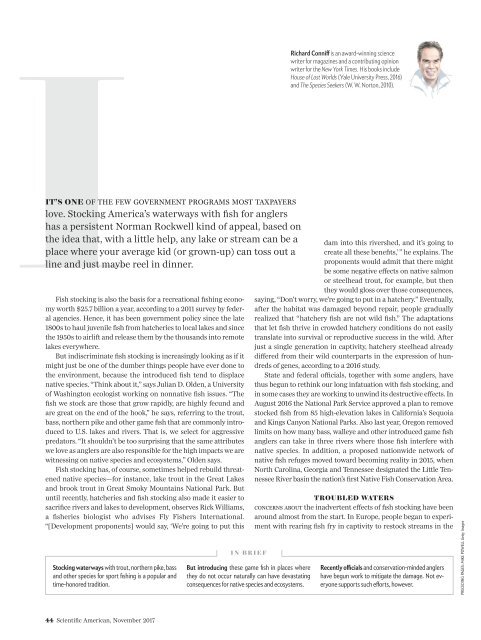scientificamerican1117-42
Create successful ePaper yourself
Turn your PDF publications into a flip-book with our unique Google optimized e-Paper software.
Richard Conniff is an award-winning science<br />
writer for magazines and a contributing opinion<br />
writer for the New York Times. His books include<br />
House of Lost Worlds (Yale University Press, 2016)<br />
and The Species Seekers (W. W. Norton, 2010).<br />
IT’S ONE OF THE FEW GOVERNMENT PROGRAMS MOST TAXPAYERS<br />
love. Stocking America’s waterways with fish for anglers<br />
has a persistent Norman Rockwell kind of appeal, based on<br />
the idea that, with a little help, any lake or stream can be a<br />
place where your average kid (or grown-up) can toss out a<br />
line and just maybe reel in dinner.<br />
IFish stocking is also the basis for a recreational fishing economy<br />
worth $25.7 billion a year, according to a 2011 survey by federal<br />
agencies. Hence, it has been government policy since the late<br />
1800s to haul juvenile fish from hatcheries to local lakes and since<br />
the 1950s to airlift and release them by the thousands into remote<br />
lakes everywhere.<br />
But indiscriminate fish stocking is increasingly looking as if it<br />
might just be one of the dumber things people have ever done to<br />
the environment, because the introduced fish tend to displace<br />
native species. “Think about it,” says Julian D. Olden, a University<br />
of Washington ecologist working on nonnative fish issues. “The<br />
fish we stock are those that grow rapidly, are highly fecund and<br />
are great on the end of the hook,” he says, referring to the trout,<br />
bass, northern pike and other game fish that are commonly introduced<br />
to U.S. lakes and rivers. That is, we select for aggressive<br />
predators. “It shouldn’t be too surprising that the same attributes<br />
we love as anglers are also responsible for the high impacts we are<br />
witnessing on native species and ecosystems,” Olden says.<br />
Fish stocking has, of course, sometimes helped rebuild threatened<br />
native species—for instance, lake trout in the Great Lakes<br />
and brook trout in Great Smoky Mountains National Park. But<br />
until recently, hatcheries and fish stocking also made it easier to<br />
sacrifice rivers and lakes to development, observes Rick Williams,<br />
a fisheries biologist who advises Fly Fishers International.<br />
“[Development proponents] would say, ‘We’re going to put this<br />
Stocking waterways with trout, northern pike, bass<br />
and other species for sport fishing is a popular and<br />
time-honored tradition.<br />
IN BRIEF<br />
But introducing these game fi sh in places where<br />
they do not occur naturally can have devastating<br />
consequences for native species and ecosystems.<br />
dam into this rivershed, and it’s going to<br />
create all these benefits,’” he explains. The<br />
proponents would admit that there might<br />
be some negative effects on native salmon<br />
or steelhead trout, for example, but then<br />
they would gloss over those consequences,<br />
saying, “Don’t worry, we’re going to put in a hatchery.” Eventually,<br />
after the habitat was damaged beyond repair, people gradually<br />
realized that “hatchery fish are not wild fish.” The adaptations<br />
that let fish thrive in crowded hatchery conditions do not easily<br />
translate into survival or reproductive success in the wild. After<br />
just a single generation in captivity, hatchery steelhead already<br />
differed from their wild counterparts in the expression of hundreds<br />
of genes, according to a 2016 study.<br />
State and federal officials, together with some anglers, have<br />
thus begun to rethink our long infatuation with fish stocking, and<br />
in some cases they are working to unwind its destructive effects. In<br />
August 2016 the National Park Service approved a plan to remove<br />
stocked fish from 85 high-elevation lakes in California’s Sequoia<br />
and Kings Canyon National Parks. Also last year, Oregon removed<br />
limits on how many bass, walleye and other introduced game fish<br />
anglers can take in three rivers where those fish interfere with<br />
native species. In addition, a proposed nationwide network of<br />
native fish refuges moved toward becoming reality in 2015, when<br />
North Carolina, Georgia and Tennessee designated the Little Tennessee<br />
River basin the nation’s first Native Fish Conservation Area.<br />
TROUBLED WATERS<br />
CONCERNS ABOUT the inadvertent effects of fish stocking have been<br />
around almost from the start. In Europe, people began to experiment<br />
with rearing fish fry in captivity to restock streams in the<br />
Recently officials and conservation-minded anglers<br />
have begun work to mitigate the damage. Not everyone<br />
supports such efforts, however.<br />
PRECEDING PAGES: MIKE POWELL Getty Images<br />
44 Scientific American, November 2017


